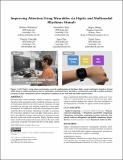Improving Attention Using Wearables via Haptic and Multimodal Rhythmic Stimuli
Author(s)
Whitmore, Nathan W; Chan, Samantha; Zhang, Jingru; Chwalek, Patrick; Chin, Sam; Maes, Pattie; ... Show more Show less
Download3613904.3642256.pdf (4.888Mb)
Publisher with Creative Commons License
Publisher with Creative Commons License
Creative Commons Attribution
Terms of use
Metadata
Show full item recordAbstract
Rhythmic light, sound and haptic stimuli can improve cognition through neural entrainment and by modifying autonomic nervous system function. However, the effects and user experience of using wearables for inducing such rhythmic stimuli have been under-investigated. We conducted a study with 20 participants to understand the effects of rhythmic stimulation wearables on attention. We found that combined sound and light stimuli from a glasses device provided the strongest improvement to attention but were the least usable and socially acceptable. Haptic vibration stimuli from a wristband also improved attention and were the most usable and socially acceptable. Our field study (N=12) with haptic stimuli from a smartwatch showed that such systems can be easy to use and were used frequently in a range of contexts but more exploration is needed to improve the comfort. Our work contributes to developing future wearables to support attention and cognition.
Date issued
2024-05-11Department
Massachusetts Institute of Technology. Media LaboratoryPublisher
ACM
Citation
Whitmore, Nathan W, Chan, Samantha, Zhang, Jingru, Chwalek, Patrick, Chin, Sam et al. 2024. "Improving Attention Using Wearables via Haptic and Multimodal Rhythmic Stimuli."
Version: Final published version
ISBN
979-8-4007-0330-0
Collections
The following license files are associated with this item: